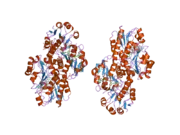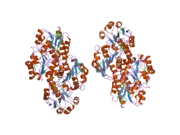| GRHPR | |||||||||||||||||||||||||||||||||||||||||||||||||||
|---|---|---|---|---|---|---|---|---|---|---|---|---|---|---|---|---|---|---|---|---|---|---|---|---|---|---|---|---|---|---|---|---|---|---|---|---|---|---|---|---|---|---|---|---|---|---|---|---|---|---|---|
 | |||||||||||||||||||||||||||||||||||||||||||||||||||
| |||||||||||||||||||||||||||||||||||||||||||||||||||
| Identifiers | |||||||||||||||||||||||||||||||||||||||||||||||||||
| Aliases | GRHPR, GLXR, GLYD, PH2, glyoxylate reductase/hydroxypyruvate reductase, glyoxylate and hydroxypyruvate reductase | ||||||||||||||||||||||||||||||||||||||||||||||||||
| External IDs | OMIM: 604296 MGI: 1923488 HomoloGene: 49088 GeneCards: GRHPR | ||||||||||||||||||||||||||||||||||||||||||||||||||
| |||||||||||||||||||||||||||||||||||||||||||||||||||
| |||||||||||||||||||||||||||||||||||||||||||||||||||
| |||||||||||||||||||||||||||||||||||||||||||||||||||
| |||||||||||||||||||||||||||||||||||||||||||||||||||
| Wikidata | |||||||||||||||||||||||||||||||||||||||||||||||||||
| |||||||||||||||||||||||||||||||||||||||||||||||||||
Glyoxylate reductase/hydroxypyruvate reductase is an enzyme that in humans is encoded by the GRHPR gene.[5][6][7]
This gene encodes an enzyme with hydroxypyruvate reductase, glyoxylate reductase, and D-glycerate dehydrogenase enzymatic activities. The enzyme has widespread tissue expression and has a role in metabolism. Type II hyperoxaluria is caused by mutations in this gene.[7] GRHPR mutation analysis needs to pay attention to primer design, because allele dropout can cause false-positive result.[8]
References
- 1 2 3 GRCh38: Ensembl release 89: ENSG00000137106 - Ensembl, May 2017
- 1 2 3 GRCm38: Ensembl release 89: ENSMUSG00000035637 - Ensembl, May 2017
- ↑ "Human PubMed Reference:". National Center for Biotechnology Information, U.S. National Library of Medicine.
- ↑ "Mouse PubMed Reference:". National Center for Biotechnology Information, U.S. National Library of Medicine.
- ↑ Rumsby G, Cregeen DP (Nov 1999). "Identification and expression of a cDNA for human hydroxypyruvate/glyoxylate reductase". Biochim Biophys Acta. 1446 (3): 383–8. doi:10.1016/S0167-4781(99)00105-0. PMID 10524214.
- ↑ Cramer SD, Ferree PM, Lin K, Milliner DS, Holmes RP (Dec 1999). "The gene encoding hydroxypyruvate reductase (GRHPR) is mutated in patients with primary hyperoxaluria type II". Hum Mol Genet. 8 (11): 2063–9. doi:10.1093/hmg/8.11.2063. PMID 10484776.
- 1 2 "Entrez Gene: GRHPR glyoxylate reductase/hydroxypyruvate reductase".
- ↑ Takaoka N, Takayama T, Miyazaki M, Nagata M, Ozono S (Dec 2008). "Modification of primers for GRHPR genotyping: avoiding allele dropout by single nucleotide polymorphisms and homology sequence". Urol Res. 36 (6): 297–302. doi:10.1007/s00240-008-0159-z. PMID 18982322. S2CID 12234158.
External links
Further reading
- Takayama T, Nagata M, Ozono S, et al. (2007). "A novel mutation in the GRHPR gene in a Japanese patient with primary hyperoxaluria type 2". Nephrol. Dial. Transplant. 22 (8): 2371–4. doi:10.1093/ndt/gfm271. PMC 2413148. PMID 17510093.
- Booth MP, Conners R, Rumsby G, Brady RL (2006). "Structural basis of substrate specificity in human glyoxylate reductase/hydroxypyruvate reductase". J. Mol. Biol. 360 (1): 178–89. doi:10.1016/j.jmb.2006.05.018. PMID 16756993.
- Mehrle A, Rosenfelder H, Schupp I, et al. (2006). "The LIFEdb database in 2006". Nucleic Acids Res. 34 (Database issue): D415–8. doi:10.1093/nar/gkj139. PMC 1347501. PMID 16381901.
- Wiemann S, Arlt D, Huber W, et al. (2004). "From ORFeome to Biology: A Functional Genomics Pipeline". Genome Res. 14 (10B): 2136–44. doi:10.1101/gr.2576704. PMC 528930. PMID 15489336.
- Gerhard DS, Wagner L, Feingold EA, et al. (2004). "The Status, Quality, and Expansion of the NIH Full-Length cDNA Project: The Mammalian Gene Collection (MGC)". Genome Res. 14 (10B): 2121–7. doi:10.1101/gr.2596504. PMC 528928. PMID 15489334.
- Lehner B, Sanderson CM (2004). "A Protein Interaction Framework for Human mRNA Degradation". Genome Res. 14 (7): 1315–23. doi:10.1101/gr.2122004. PMC 442147. PMID 15231747.
- Ota T, Suzuki Y, Nishikawa T, et al. (2004). "Complete sequencing and characterization of 21,243 full-length human cDNAs". Nat. Genet. 36 (1): 40–5. doi:10.1038/ng1285. PMID 14702039.
- Strausberg RL, Feingold EA, Grouse LH, et al. (2003). "Generation and initial analysis of more than 15,000 full-length human and mouse cDNA sequences". Proc. Natl. Acad. Sci. U.S.A. 99 (26): 16899–903. Bibcode:2002PNAS...9916899M. doi:10.1073/pnas.242603899. PMC 139241. PMID 12477932.
- Simpson JC, Wellenreuther R, Poustka A, et al. (2001). "Systematic subcellular localization of novel proteins identified by large-scale cDNA sequencing". EMBO Rep. 1 (3): 287–92. doi:10.1093/embo-reports/kvd058. PMC 1083732. PMID 11256614.
- Hartley JL, Temple GF, Brasch MA (2001). "DNA Cloning Using In Vitro Site-Specific Recombination". Genome Res. 10 (11): 1788–95. doi:10.1101/gr.143000. PMC 310948. PMID 11076863.
- Webster KE, Ferree PM, Holmes RP, Cramer SD (2000). "Identification of missense, nonsense, and deletion mutations in the GRHPR gene in patients with primary hyperoxaluria type II (PH2)". Hum. Genet. 107 (2): 176–85. doi:10.1007/s004390000351. PMID 11030416. S2CID 10574729.
- Huang T, Yang W, Pereira AC, et al. (2000). "Cloning and characterization of a putative human d-2-hydroxyacid dehydrogenase in chromosome 9q". Biochem. Biophys. Res. Commun. 268 (2): 298–301. doi:10.1006/bbrc.2000.2122. PMID 10679197.
This article is issued from Wikipedia. The text is licensed under Creative Commons - Attribution - Sharealike. Additional terms may apply for the media files.








